Blog
Friday April 26th 6pm. Accompanying the Shabbat Service with Inbal Sharett-Singer, Jayson Rodovsky, Jeff Bailey, Pete Whitman and mick laBriola.
more...The Rosette Nebula (also known as Caldwell 49) is an H II region located near one end of a giant molecular cloud in the Monoceros region of the Milky Way Galaxy. The open cluster NGC 2244(Caldwell 50) is closely associated with the nebulosity, the stars of the cluster having been formedfrom the nebula’s matter.
The nebula has been noted to be having a shape reminiscent of a human skull, and is sometimes referred to as the “Skull Nebula.” It is not to be confused with NGC 246, which is also nicknamed the “Skull Nebula. Here is the panoramic photo of the Rosette Nebula, Cone Nebula, Christmas tree.
Following these two clear nights, without a Moon at the start of the night, I took a wide shot of the Rosette nebula, of the cone / Christmas tree, there are 3 photos with the 300mm f2.8 canon to make this panorama.
There are 4 hours per panel with unit exposures of 5 min.
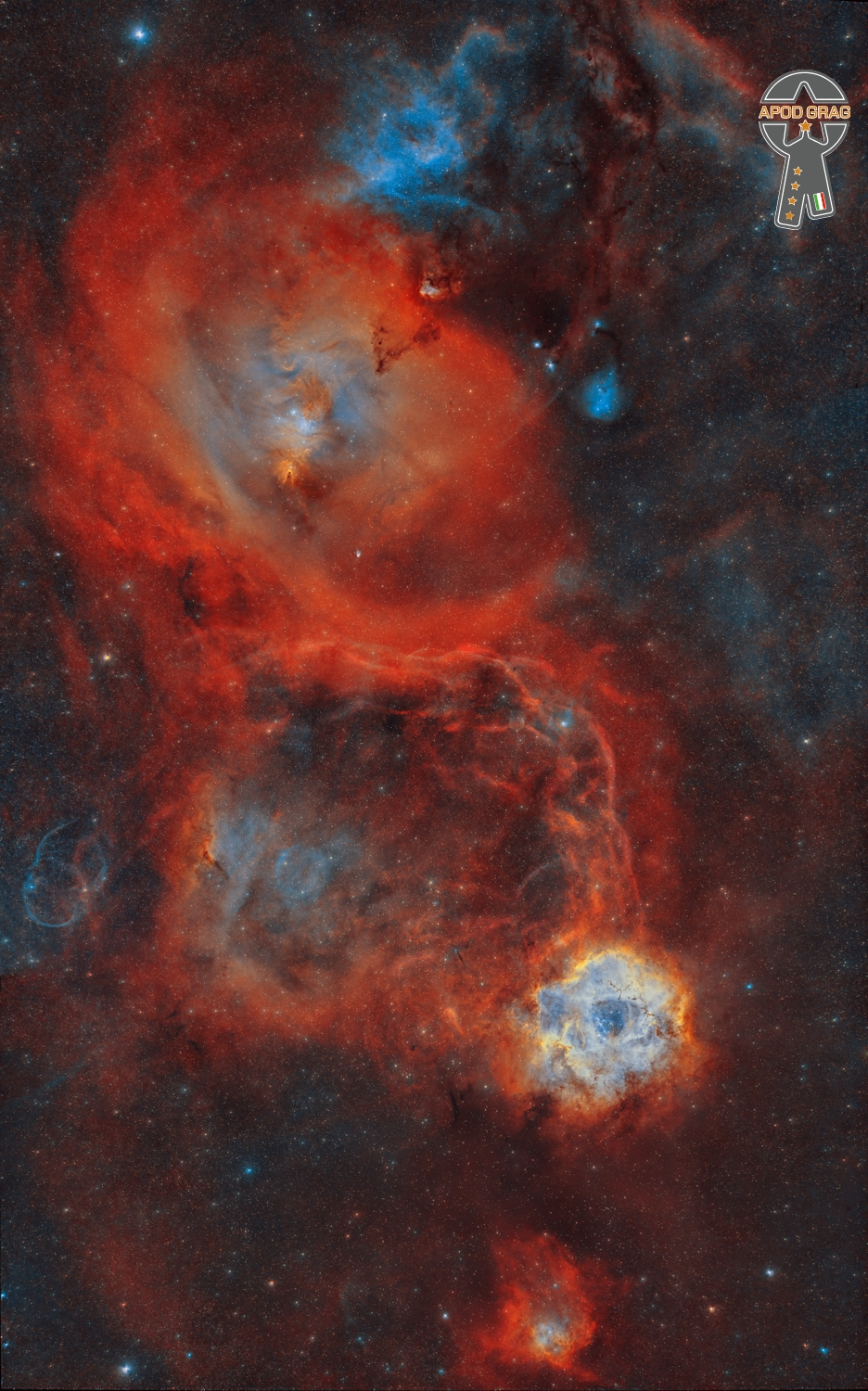
more...
Shankar Lakshminarayana (born 26 April 1950), better known as L. Shankar, is an Indian violinist, singer and composer who also goes by the stage name Shenkar. Known for his innovative contributions to world music, he is often regarded as one of the pioneers of East- West fusion, blending the rich traditions of Indian classical with Western genres such as jazz, rock, and electronic music. His world music albums with the band Shakti during the mid-70s became the ‘standard to gauge the playing and composing abilities of any world musician following in Shakti’s expansive wake”. He is credited with inventing the stereophonic double violin (known as the LSD – L.Shankar Double Violin), which covers the orchestral string family’s range. In 1990, Shankar’s talam-bending (time cycles of 9 3/4 & 6 3/4 beats) Pancha Nadai Pallavi’ album was on the Billboard top ten world music chart for three months becoming the first traditional Indian record to reach those heights. His 1995 Raga Abheri album was nominated for a Grammy Award, in the Best World Music Album category.With Peter Gabriel, he worked on the Grammy winning album Passion(1989), the soundtrack album for Martin Scorsese’s The Last Temptation of Christ(1988), and wrote and performed vocals on Mel Gibson’s ‘The Passion of the Christ’ (2004) which won a Dove Award for Instrumental Album of the Year at the 36th GMA Dove Awards. He also worked on the soundtrack for the 2002 film Queen of the Damned with Jonathan Davis and Richard Gibbs and recorded eight songs of which five were picked for the movie. Additionally, he collaborated on the original score for NBC’s hit TV series Heroes with Wendy & Lisa. As an acclaimed musician, Shankar is ranked as one of the top famous male violinists by Ranker and one amongst the greatest violinists of popular music by Digital Dream Door. His extensive body of work spans a wide spectrum of genres, encompassing vocal and instrumental compositions.
more...Theodore Marcus “Teddy” Edwards (April 26, 1924 – April 20, 2003) was an American jazz tenor saxophonist.
Edwards was born in Jackson, Mississippi, United States. He learned to play at a very early age, first on alto saxophone and then clarinet.
His uncle sent for him to come to Detroit to live because he felt opportunities were better. Due to illness in the family, he went back to Jackson and ventured to Alexandria, Louisiana. He was persuaded by Ernie Fields to join his band after going to Tampa, Florida. Edwards had planned to go to New York City, but Fields convinced him he could get there by way of Washington, D.C., if he worked with his band. Edwards ended up at the “Club Alabam” on Central Avenue in Los Angeles, which later became his city of residence.
more...John Ned Shines (April 26, 1915 – April 20, 1992) was an American blues singer and guitarist.
Shines was born in Frayser, Tennessee, today a neighborhood of Memphis. He was taught to play the guitar by his mother and spent most of his childhood in Memphis, playing slide guitar at an early age in juke joints and on the street. He moved to Hughes, Arkansas, in 1932 and worked on farms for three years, putting aside his music career. A chance meeting with Robert Johnson, his greatest influence, gave him the inspiration to return to music. In 1935, Shines began traveling with Johnson, touring in the United States and Canada.[1] They parted in 1937, one year before Johnson’s death.
Shines played throughout the southern United States until 1941, when he settled in Chicago. There he found work in the construction industry but continued to play in local bars.
He made his first recording in 1946 for Columbia Records, but the takes were never released. He recorded for Chess Records in 1950, but again no records were released. He kept playing with blues musicians in the Chicago area for several more years. In 1952, Shines recorded what is considered his best work, for J.O.B. Records. The recordings were a commercial failure, and Shines, frustrated with the music industry, sold his equipment and returned to working in construction.
more...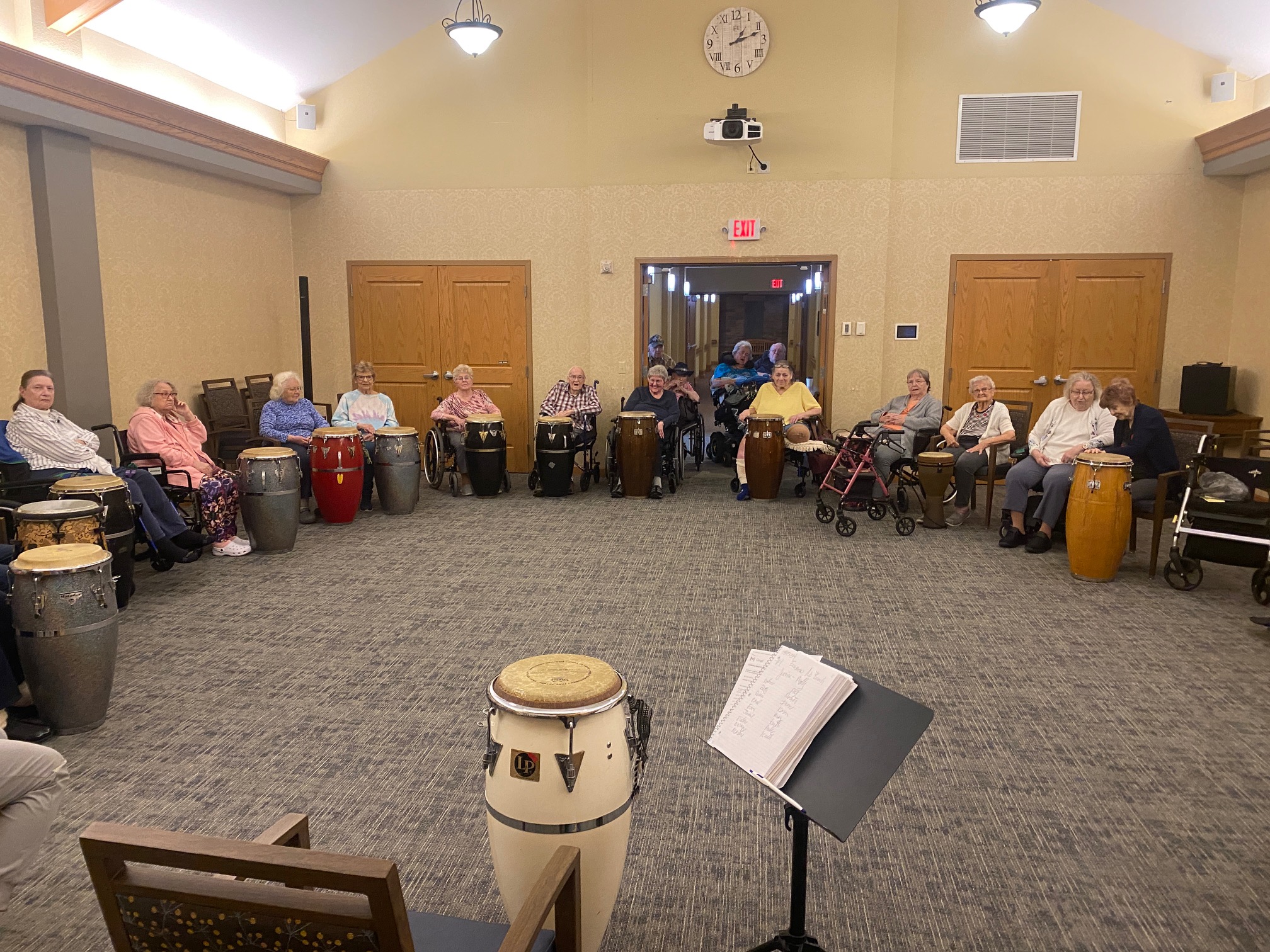
Located some 3 million light-years away in the arms of nearby spiral galaxy M33, giant stellar nursery NGC 604 is about 1,300 light-years across. That’s nearly 100 times the size of the Milky Way’s Orion Nebula, the closest large star forming region to planet Earth. In fact, among the star forming regions within the Local Group of galaxies, NGC 604 is second in size only to 30 Doradus, also known as the Tarantula Nebula in the Large Magellanic Cloud. Cavernous bubbles and cavities in NGC 604 fill this stunning infrared image from the James Webb Space Telescope’s NIRCam. They are carved out by energetic stellar winds from the region’s more than 200 hot, massive, young stars, all still in early stages of their lives.
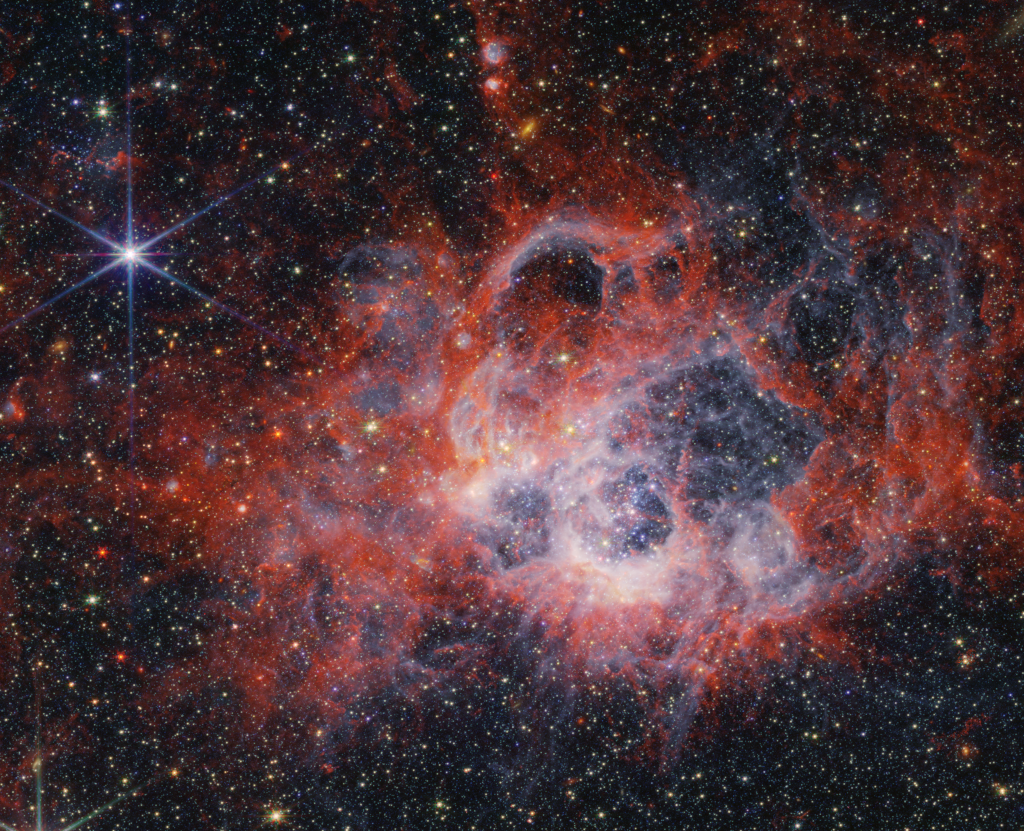
more...
Carl Allen (born April 25, 1961) is an American jazz drummer.
Allen attended William Paterson University.
He has worked with a wide variety of musicians, including Freddie Hubbard, Jackie McLean, George Coleman, Phil Woods, the Benny Green Trio, and Rickie Lee Jones.
It was with Green that Allen met bassist Christian McBride. The two have teamed up frequently, working for many combos of big name leaders. McBride recruited Allen for his band, Christian McBride & Inside Straight. Allen is that quintet’s drummer for both its first recording, Kinda Brown, and its road tours.
In 1988, Allen and Vincent Herring founded Big Apple Productions, which produced several albums featuring young jazz performers.
He joined the faculty of The Juilliard School in 2001 and became the Artistic Director of Jazz Studies in 2008. He was replaced as director by Wynton Marsalis in 2013 and left Juilliard at the end of the academic year.
more...Albert Nelson (April 25, 1923 – December 21, 1992 Indianola, MS), known by his stage name Albert King, was an African-American guitarist and singer who is often regarded as one of the greatest and most influential blues guitarists of all time. He is perhaps best known for his popular and influential album Born Under a Bad Sign (1967) and its title track. He, B.B. King, and Freddie King, all unrelated, were known as the “Kings of the Blues”. The left-handed Albert King was known for his “deep, dramatic sound that was widely imitated by both blues and rock guitarists”.
He was once nicknamed “The Velvet Bulldozer” because of his smooth singing and large size – he stood taller than average, with sources reporting 6 ft 4 in (1.93 m) or 6 ft 7 in (2.01 m), and weighed 250 lb (110 kg) – and also because he drove a bulldozer in one of his day jobs early in his career.
King was inducted into the Blues Hall of Fame in 1983. He was posthumously inducted into the Rock and Roll Hall of Fame in 2013. In 2023, he was ranked number 22 on Rolling Stone‘s 250 Greatest Guitarists of All Time.
more...Ella Jane Fitzgerald (April 25, 1917 – June 15, 1996) Newport News, VA was an American jazz singer, sometimes referred to as the “First Lady of Song”, “Queen of Jazz”, and “Lady Ella”. She was noted for her purity of tone, impeccable diction, phrasing, timing, intonation, and a “horn-like” improvisational ability, particularly in her scat singing.
After a tumultuous adolescence, Fitzgerald found stability in musical success with the Chick WebbOrchestra, performing across the country but most often associated with the Savoy Ballroom in Harlem. Her rendition of the nursery rhyme “A-Tisket, A-Tasket” helped boost both her and Webb to national fame. After taking over the band when Webb died, Fitzgerald left it behind in 1942 to start her solo career. Her manager was Moe Gale, co-founder of the Savoy, until she turned the rest of her career over to Norman Granz, who founded Verve Records to produce new records by Fitzgerald. With Verve, she recorded some of her more widely noted works, particularly her interpretations of the Great American Songbook.
Fitzgerald also appeared in films and as a guest on popular television shows in the second half of the twentieth century. Outside her solo career, she created music with Louis Armstrong, Duke Ellington, and The Ink Spots. These partnerships produced songs such as “Dream a Little Dream of Me“, “Cheek to Cheek“, “Into Each Life Some Rain Must Fall“, and “It Don’t Mean a Thing (If It Ain’t Got That Swing)“. In 1993, after a career of nearly sixty years, she gave her last public performance. Three years later, she died at age 79 after years of declining health. Her accolades included 14 Grammy Awards, the National Medal of Arts, the NAACP‘s inaugural President’s Award, and the Presidential Medal of Freedom.
more...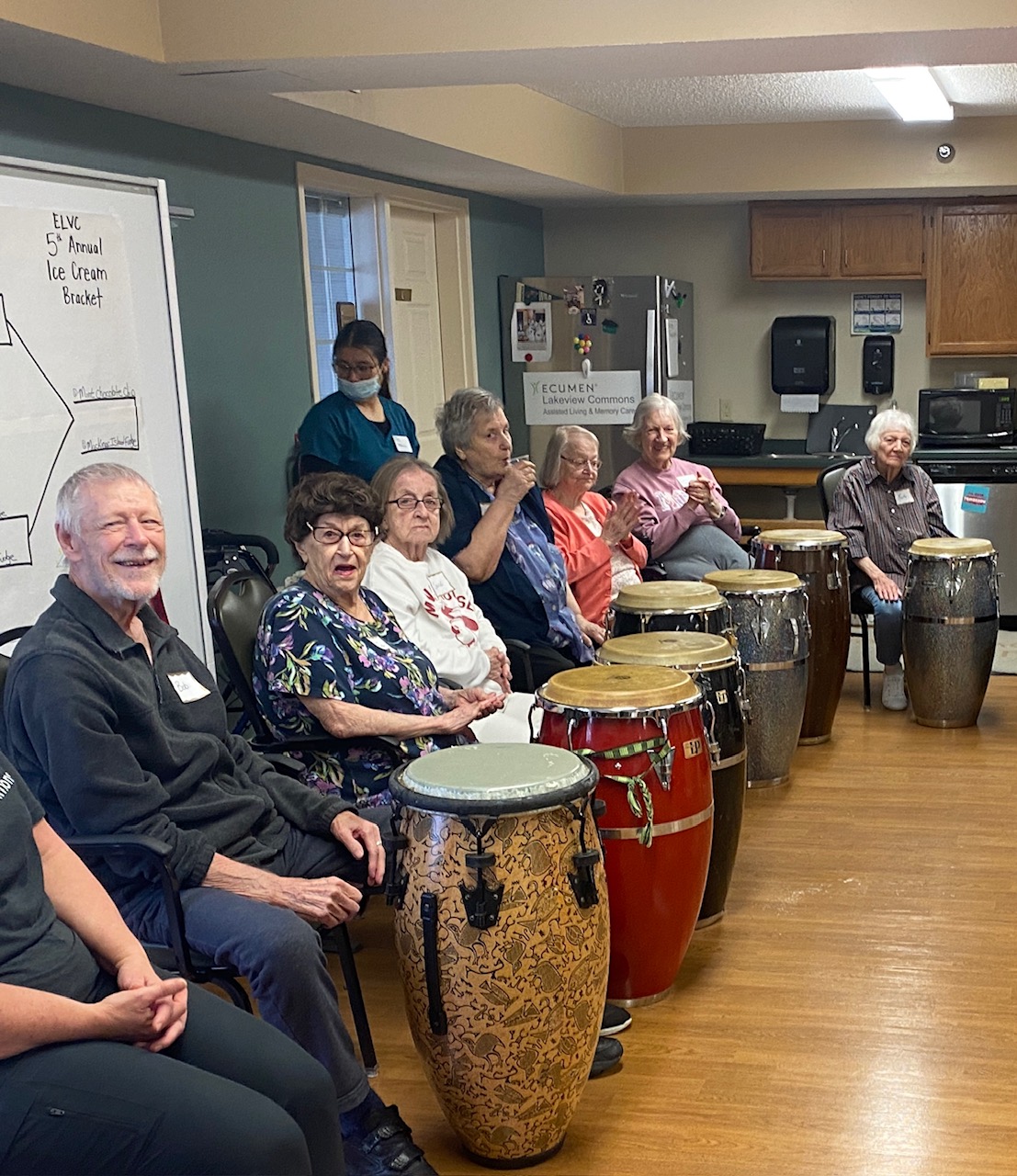
In the middle of emission nebula NGC 6164 is an unusually massive star. The central star has been compared to an oyster’s pearl and an egg protected by the mythical sky dragons of Ara. The star, visible in the center of the featured image and catalogued as HD 148937, is so hot that the ultraviolet light it emits heats up gas that surrounds it. That gas was likely thrown off from the star previously, possibly the result of a gravitational interaction with a looping stellar companion. Expelled material might have been channeled by the magnetic field of the massive star, in all creating the symmetric shape of the bipolar nebula. NGC 6164 spans about four light years and is located about 3,600 light years away toward the southern constellation Norma.
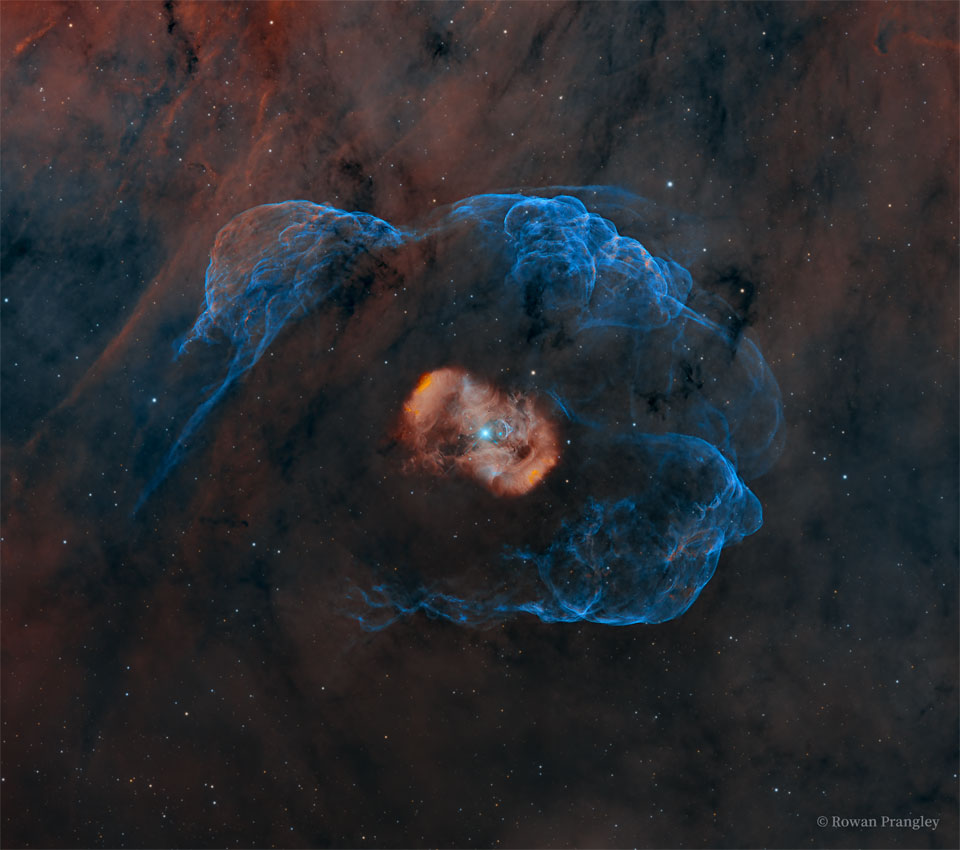
Reuben Bloom (April 24, 1902 – March 30, 1976) was an American songwriter, pianist, arranger, band leader, recording artist, vocalist, and author.
Bloom was born and died in New York City. He was Jewish.
During his career, he worked with many well-known performers, including Bix Beiderbecke, Joe Venuti, Ruth Etting, Stan Kenton, Tommy and Jimmy Dorsey. He collaborated with a wide number of lyricists, including Johnny Mercer, Ted Koehler, and Mitchell Parish.
During the 1920s he wrote many novelty piano solos, which are still well regarded today. He recorded for the Aeolian Company’s Duo-Art reproducing piano system various titles including his “Spring Fever”. His first hit came in 1927 with “Soliloquy”; his last was “Here’s to My Lady” in 1952, which he wrote with Johnny Mercer. In 1928, he made a number of records with Joe Venuti’s Blue Four for OKeh, including five songs he sang, as well as played piano.
more...John Christopher Williams AO OBE (born 24 April 1941) is an Australian-born classical guitarist renowned for his ensemble playing as well as his interpretation and promotion of the modern classical guitar repertoire. In 1973, he shared a Grammy Award in the Best Chamber Music Performance category with fellow guitarist Julian Bream for Together (released in the US as Julian and John (Works by Lawes, Carulli, Albéniz, Granados)). Guitar historian Graham Wade has said that “John is perhaps the most technically accomplished guitarist the world has seen.”
John Williams is an only child who was born on 24 April 1941 in Melbourne to an English father, Len Williams, who bought John, at age four, his first guitar with a modified neck. Len would later found the Spanish Guitar Centre in London, England. John’s mother Melaan (née Ah Ket) was the daughter of William Ah Ket, the first Australian barrister of Chinese heritage. In 1952, the family moved to England, where John attended Friern Barnet Grammar School, London.
Williams was initially taught guitar by his father, who was a musically disciplined and accomplished classical guitarist. From the age of 11, Williams attended summer courses with Andrés Segovia at the Accademia Musicale Chigiana in Siena, Italy. He attended the Royal College of Music in London, from 1956 to 1959, studying piano because the college did not have a guitar section. In 1958, when he was 17 years old, he made his musical debut performing publicly at London’s Wigmore Hall. Upon graduating from his college, he was invited to create and then to run their guitar department for its first two years of life. Williams maintains links with the college (and also with the Royal Northern College of Music in Manchester).
more...More Posts
- World Music AZAYA ft. DJELYKABA BINTOU
- Daily Roots Al Campbell
- Cosmos Aurora Iceland
- Lee Ritenour
- Wilton Bogey Gaynair
- World Music Yacouba Sissoko
- Daily Roots Earl Lowe
- Cosmos NGC 2264
- Rod Stewart
- Aynsley Dunbar
- Jim Croce
- William Parker
- Sam Chatman
- Max Roach
- SAVE UKRAINIE World Music Trio Mandili
- Daily Roots HepCat
- RENT the Musical
- Cosmos LEDA 48062
- Jimmy Page
- Joan Baez
